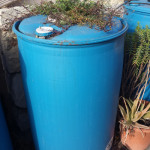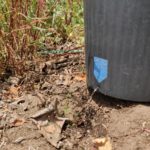A Thick Quilt of Mulch
“Nature abhors bare soil,” said French Permaculturist Emilia Hazelip. When you take a hike in the mountains, have you ever noticed how the shrubs drop a thick layer of leaves? In their natural state, shrubs make their own mulch.
Peel back a thick layer of garden mulch, particularly in the springtime when everything is still moist. Right at the interface between mulch and soil you’ll notice a very rich layer. You might catch a few soil critters scampering away. You might see some long threads of mysterious white stuff – this is mycorrhizal fungus. There also are unfathomable numbers of organisms you can’t see with the naked eye.
Mulch serves many very important purposes. Here in Southern California, one of the primary ones is holding moisture in the soil by slowing evaporation. Just like for the tiny pet dog, we need to make sure our soil critters have adequate water. If the soil dries out, the mobile soil critters dive deep to survive – to depths where they no longer do your plants any good. The non-mobile ones dry up and go dormant or die.
Mulch provides shelter for our rich population of soil critters. It can help protect them from the UV rays of the sun. It can slow weed germination. It prevents wind erosion and can help slow water erosion.
At the Community Garden at Holy Nativity, our footpaths are covered with mulch. About once a year we ask the local tree trimming service to leave us a load of wood chips. We distribute them everywhere on the site. Paths. Perennial plantings. Bare spaces lying fallow. Mulch doesn’t have to be uniform – the soil critters don’t really care. You can use whatever organic material you have lying around – anything that used to be plants.
Some cities offer free mulch to their citizens. Here in L.A. you can pick it up on a D-I-Y basis at various sites around the city. Some people use this material in abundance. We opted not to use it when I learned that ours is simply the contents of all the local neighbors’ green trash bins, run through chipping equipment. Thus anything that went into our neighbors’ “green waste” barrel (trash, plastic, glass, diseased plants, invasive weeds, dog droppings) is in that “mulch.” While that might be fine for ornamentals and native plants, for food plants I prefer to know exactly what material I am using.
Some types of plants release allelopathic compounds which prevent other plants from sprouting up around them. Eucalyptus, walnut, and cedar are renowned for this, thus pure eucalyptus, walnut, or cedar chips aren’t recommended for mulch. (Small portions of eucalyptus, well blended in with other plant chips, in our observation don’t seem to be harmful.) My sister and I have also noticed the allelopathic phenomenon with the bagged redwood bark chips from the garden center. In beds mulched with these, sprouting of vegetable seedlings seemes to be inhibited. As in all things, it is important to have a relationship with your vendor. Ask. Our friendly tree trimmer lets us know when he has a “clean load” of good chips.


